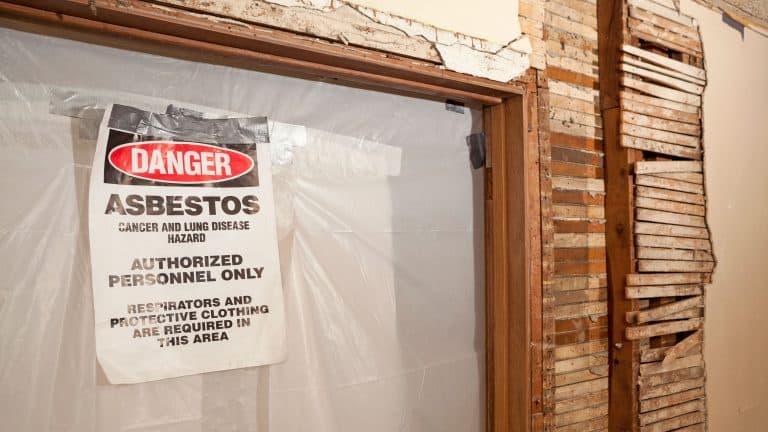How Asbestos Exposure Causes Diseases
The U.S. Department of Health and Human Services, the U.S. Environmental Protection Agency, and the World Health Organization are among the numerous health agencies that have classified asbestos as a human carcinogen or cancer-causing substance.(1) (2)
The toxic group of minerals once widely used in thousands of commercial products forms as microscopic fibers. When asbestos-containing materials deteriorate, are disturbed or manipulated, the fibers are released into the air.

Once inhaled, these fibers can get stuck deep in your lungs. The buildup of fibers remains in your lung tissue for a long time and may cause scarring and inflammation. This can lead to deadly diseases.(3)
About Asbestos-Related Diseases
Unfortunately, the dangers of asbestos do not disappear once the exposure stops. Asbestos-related diseases develop slowly over time. The symptoms, such as pain, fatigue, and shortness of breath, may not arise until 10 to 50 or more years after a person’s first contact with asbestos. Even then, these diseases can be hard to detect because the signs often mirror those of less severe illnesses.(4) By the time a doctor diagnoses an asbestos-related disease, it is often at a late stage of development.
To date, no treatments have reversed or cured the most deadly effects of asbestos, mesothelioma, though some aim to help relieve symptoms. These treatments or treatments for lung cancer and asbestosis can be expensive, debilitating, and a burden on victims and their loved ones already coping with life-altering illness. In addition, asbestos-related diseases may cause fear, anxiety, depression, and stress.(5)
Types of Asbestos-Related Diseases
Asbestos-related diseases can be cancerous or noncancerous. Even a benign asbestos illness, such as asbestosis, can be extremely serious, contributing to more than a thousand U.S. deaths each year.
Have you or your loved one suffered complications due to asbestos exposure? We offer a free legal consultation.
Get a Free Case ReviewMesothelioma
Mesothelioma is known as the signature asbestos-related cancer. It is also the most deadly asbestos-related disease.
An aggressive cancer, mesothelioma develops on the thin protective linings of the chest, abdomen, heart, or testicles. Doctors diagnose an estimated 3,000 new cases of mesothelioma in the U.S. each year, many of which can be traced to job-related asbestos exposure.(6)
Pleural Mesothelioma (lungs)
Peritoneal Mesothelioma (abdomen)
Pericardial Mesothelioma (heart)
Testicular Mesothelioma
While each type of mesothelioma may yield different symptoms, patients — regardless of their specific diagnosis — may experience pain and unexplained weight loss.(7)
Asbestos Lung Cancer
The U.S. Department of Labor has warned of a clear connection between asbestos exposure and lung cancer, which is the leading cause of cancer death in the U.S.(8)
Of the more than 200,000 new lung cancer cases each year, as much as 15% are caused by occupational exposures to carcinogens, including asbestos.(9)
The two primary forms of lung cancer are:
- Non-Small Cell Lung Cancer — a less aggressive and more common form that accounts for at least 80% of all cases.(10)
- Small Cell Lung Cancer — an aggressive form that spreads quickly throughout the body. It makes up less than 20% of cases.
Symptoms of lung cancer may include shortness of breath, fatigue, chest pain, worsening or ongoing cough, and weight loss.(11)
Asbestosis
Asbestosis is a chronic lung condition caused exclusively by inhaled asbestos fibers that become lodged in the lungs. Scar tissue forms inside the lungs, preventing them from expanding and contracting normally.(12)
This makes breathing difficult and painful. The disease is progressive, some people with asbestosis eventually die of respiratory failure.(13)
Symptoms include shortness of breath with activity, tightness in the chest, and coughing.(14)
Asbestos Disease Deaths
Globally, “asbestos causes an estimated 255,000 deaths annually.” Of these deaths, “work-related exposures are responsible for 233,000” of them. (15)
Asbestos causes almost 40,000 deaths each year in the United States. (16) The total number of asbestos-associated deaths in the U.S. is estimated to potentially exceed 200,000 by the year 2030.(17)
Occupations at Risk
Normally, the risk of asbestos-related diseases is said to be greatest for people who have worked with asbestos and were exposed to visible dust containing asbestos fibers for some time.(18) However, investigators have found people with only brief exposures have developed asbestos-related diseases.(19)
Those at risk for asbestos exposure in the workplace include miners, building construction workers, brake mechanics, electricians, shipyard workers, boiler operators, building engineers, and railroad workers. In addition, veterans may have encountered asbestos while serving in the U.S. military. Family members of people exposed to asbestos on the job also may be at risk of asbestos diseases from inhaling asbestos fibers brought home on workers’ clothing.(20)
How Weitz & Luxenberg Can Help
If you were exposed to asbestos and have been diagnosed with mesothelioma, lung cancer, or asbestosis, you may be eligible for compensation for your pain and suffering. Putting your trust in a reputable asbestos attorney can be a great benefit when seeking compensation for your asbestos-related injuries.
Weitz & Luxenberg has earned national acclaim for our pioneering work in asbestos litigation. For almost 40 years, we have provided caring and expert representation to those affected by asbestos-related diseases — both patients and their surviving loved ones.
Our attorneys are committed to helping each victim achieve the justice he or she deserves. We will stand behind you and help you through this scary and difficult time.
For a free legal consultation call (917) LAWYERS or fill out a form to speak with one of our dedicated asbestos attorneys.
